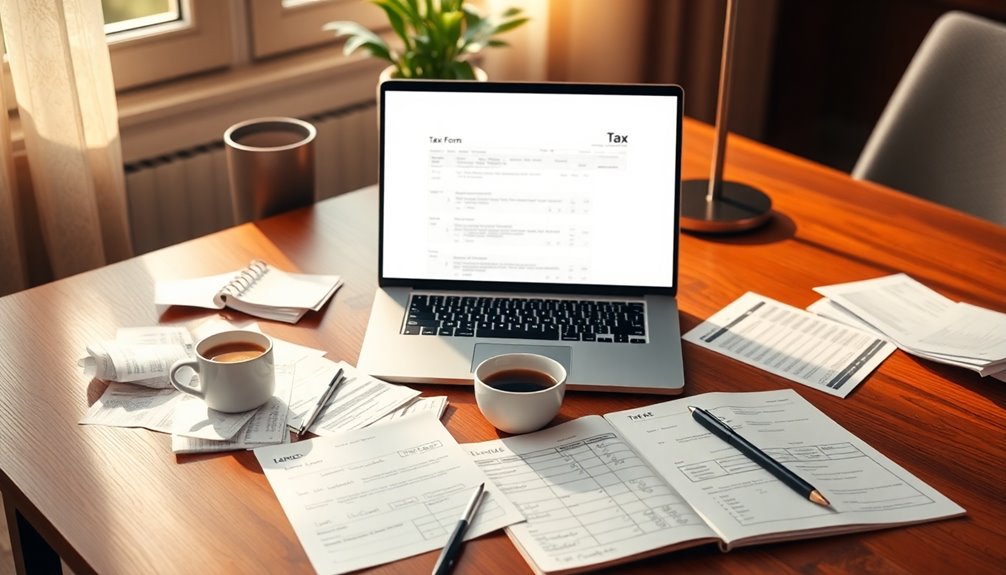You can file your taxes without a W-2 by gathering the necessary documentation and using Form 4852 as a substitute. Start by collecting your income records, including any 1099 forms from freelance or contract work. Make sure to note all wages, tips, and withheld taxes. If you can't get your W-2 from your employer, fill out Form 4852 with your employment details and attach it to your paper tax return. Remember, online filing isn't allowed with Form 4852. Properly keeping your records can help you meet IRS requirements. There's more to explore about this process, so keep going.
Key Takeaways
- Gather all income documentation, including 1099 forms for freelance work and detailed records of any other income sources.
- Use Form 4852 as a substitute for a missing W-2; attach it to your paper tax return if necessary.
- Track all expenses meticulously, as self-employed individuals can deduct business-related costs to reduce taxable income.
- Consider filing for an extension if waiting for a W-2; however, any taxes owed are still due by the original deadline.
- Seek assistance from tax professionals to navigate complex situations and maximize deductions and credits available to you.
Obtaining a W-2 Form

When it comes to obtaining your W-2 form, it's crucial to know the deadlines and procedures involved. Employers are required to provide W-2s by January 31 each year. If that date falls on a weekend or holiday, you'll receive it by the next business day.
While employers can send W-2s electronically, it's not mandatory, so be sure to check your inbox or mail. If you haven't received your W-2 by mid-February, don't hesitate to reach out to your employer. You can request a copy, and they've 30 days to provide it. Just make sure your address is up to date in their records.
Many employers also offer online access to W-2 forms through their HR departments, allowing you to download or print your W-2 directly. Additionally, W-2 forms must be furnished to recipients by January 31, highlighting the importance of timely communication with your employer.
If all else fails and you still haven't received your W-2, contact the IRS for assistance. Be ready to provide details about your employment dates and estimated wages, as the IRS may need to verify this information with your employer. Following these steps will ensure you get your W-2 and can move forward with your tax filing.
Using Form 4852

If you haven't received your W-2, using Form 4852 can help you file your taxes accurately. Start by filling out your name, address, and Social Security number on the form. Make sure you note the correct tax year and include your employer's name, address, and employer identification number (EIN).
To estimate your income and withholding, refer to your last pay stub or any relevant documents you have. When you calculate your total wages or distributions for the year, ensure you include federal income tax withheld, and if applicable, state or local income tax withheld. It's important to remember that Form 4852 is used as a backup for missing or incorrect W-2 or 1099-R forms, allowing taxpayers to report wages and calculate taxes independently.
It's crucial to match your estimated amounts with your records to avoid discrepancies. Once you've completed Form 4852, attach it to your paper tax return along with any other necessary forms.
Remember, you can't e-file Form 4852 directly, but you can use tax preparation software for the rest of your return. After mailing your completed return, keep a signed copy of Form 4852 for your records.
If you later receive your original W-2 or 1099-R, be prepared to file an amended return if needed.
Required Information for Filing

To file your taxes accurately without a W-2, you'll need to gather specific information about your employer and your earnings. Start with your employer's name, address, and identification number. You'll also need to know the federal, state, and local income taxes withheld from your income.
Next, collect your wage and compensation details. This includes complete wages, tips, and any Social Security, Medicare wages, and local taxes withheld. If you worked as a household employee, make sure to document those wages as well, even if they weren't reported on a W-2. It's important to remember that filing taxes without W-2 is technically legal when you have the necessary information.
Don't forget about tax withholdings and payments. Keep track of the Social Security and Medicare taxes withheld, any estimated tax payments made during the year, and any prior-year refunds applied to this year.
Additionally, gather Social Security numbers and dates of birth for yourself, your spouse, and any dependents. Record other income sources, documentation for deductions and credits, and your bank account details for potential direct deposits or payments.
If applicable, include information for any foreign bank accounts for FBAR reporting.
Filing Taxes Via Mail or Online

After gathering all the necessary information for filing your taxes without a W-2, you can choose between mailing your return or filing online.
If you opt to mail your return, you'll need to attach Form 4852, as the IRS doesn't allow electronic filing for it. Use your final pay stub to estimate your wages and withholding when completing Form 4852. You should also notify the IRS about the missing W-2 and your attempts to obtain it. Remember, processing times may be longer for returns with this form. Additionally, you must ensure that your employer provides the W-2 by January 31 to avoid complications in your filing.
If you prefer online filing, keep in mind that you can't e-file using Form 4852. Many online tax preparation software programs mightn't support this form, and you can't use Wage and Income Transcripts for e-filing either due to missing state tax information.
To avoid issues, consider waiting for your actual W-2 or request a Wage and Income Transcript online. If you find yourself needing more time, you might want to request a filing extension.
Always consult with tax professionals for assistance if you're unsure about your options.
Potential Consequences and Follow-Up

Filing your taxes without a W-2 can lead to several potential consequences that you need to be aware of. If you file late or miss a W-2, the IRS could impose penalties ranging from $60 to $660 per form, depending on how late you're and whether the delay was intentional.
For example, filing within 30 days incurs a $60 penalty, while filing after August 1 could cost you $330. If the IRS believes you intentionally disregarded filing requirements, you could face a hefty penalty of $660 per W-2, with no maximum limit. Penalties for failing to send completed W-2s can escalate significantly based on how late the forms are filed, emphasizing the importance of timely submissions.
Errors on your W-2 can also result in penalties. Incorrect information may trigger audits and additional fines, especially if you use the wrong tax identification numbers or report inaccurate wages.
If you discover a mistake after filing, you'll need to submit an amended tax return using Form 1040X, which can take 10-12 weeks to process.
Lastly, if your tax return doesn't match the W-2, the IRS might audit you. To avoid penalties, document your good faith efforts to comply with filing requirements and act promptly to correct any mistakes.
Additional Resources and Alternatives

When you don't have a W-2, several alternatives and resources can help you navigate the tax filing process. First, try requesting a copy from your employer if you haven't received it or if it's lost. If that fails, you can use Form 4852, the "Substitute for Form W-2," and base it on your final pay stub or estimated earnings.
Make sure to gather essential information like Medicare wages, Social Security wages, and the federal tax withheld. For free tax filing services, check out the IRS Free File program if your adjusted gross income is $79,000 or less, as it provides free software for eligible individuals. Many tax software providers also offer free tiers for simple returns.
If you need in-person help, visit local VITA sites or use GetYourRefund.org for virtual assistance with certified volunteers.
Remember to comply with both federal and state tax deadlines. While filing, keep all related documents organized for potential audits.
If your situation is complex, consider hiring a tax professional. They can help ensure you meet all requirements while maximizing your deductions.
With these resources, you can confidently file your taxes without a W-2.
Frequently Asked Questions
Can I File Taxes Without Any Income Documentation?
Yes, you can file taxes without any income documentation, but it's not typical.
If you've got no income to report, you don't have to file unless certain conditions apply, like self-employment.
However, if you choose to file, estimate your income to the best of your ability.
Just remember, the IRS might reject a return without any taxable income, so consider reporting a small amount to avoid that issue.
What if I Worked Multiple Jobs but Lost All W-2s?
If you worked multiple jobs but lost all your W-2s, don't panic.
Start by contacting each employer's payroll or HR department to request copies. Verify your address to ensure they sent the W-2s correctly.
If they're unresponsive, use your last pay stubs to estimate your earnings and fill out Form 4852. Attach it to your tax return, and keep detailed records of your attempts to retrieve the W-2s.
How Do I Estimate My Income Without a W-2?
To estimate your income without a W-2, gather all your pay stubs from the year and calculate your total wages and tax withholdings.
Use the year-to-date totals from your final pay stub for accuracy. If necessary, complete Form 4852 with your estimates, and remember to paper-file it.
You can also request an IRS Wage and Income Transcript to verify your information and ensure your estimates align with any reported income data.
Are There Penalties for Filing Taxes Late Without a W-2?
Yes, there are penalties for filing taxes late.
If you miss the deadline but file within 30 days, you'll face a $60 penalty per W-2.
If you file between 31 days and August 1, the penalty increases to $120 per W-2.
Filing after August 1 can cost you $310 per W-2.
Intentional disregard of filing requirements can lead to even steeper penalties, so it's best to file on time whenever possible.
Can I Request My W-2 From the IRS Directly?
Yes, you can request your W-2 from the IRS directly, but it mightn't be the fastest route.
You'll need to use Form 4506-T or call the IRS self-service line.
Keep in mind that the IRS won't send a W-2 copy until they've received it from your employer.
It's often quicker to contact your employer for a copy if you need it sooner.
Just remember to allow time for processing.
Conclusion
Filing taxes without a W-2 might seem daunting, but it's definitely doable. By using Form 4852 and gathering the necessary information, you can still file your taxes accurately. Whether you choose to mail your forms or file online, just make sure to keep track of your submission. If you have any questions or run into issues, don't hesitate to reach out for help. You've got this, and you'll be on your way to a smooth tax season!









